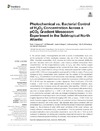Identificador persistente para citar o vincular este elemento:
https://accedacris.ulpgc.es/jspui/handle/10553/46022
| Título: | Photochemical vs. bacterial control of H2O2 concentration across a pCO2 gradient mesocosm experiment in the subtropical North Atlantic | Autores/as: | Hopwood, Mark J. Riebesell, Ulf Arístegui, Javier Ludwig, Andrea Achterberg, Eric P. Hernández, Nauzet |
Clasificación UNESCO: | 251002 Oceanografía química | Palabras clave: | Hydrogen peroxide H2O2 Mesocosm Atlantic pCO2 |
Fecha de publicación: | 2018 | Publicación seriada: | Frontiers in Marine Science | Resumen: | In the surface ocean, microorganisms are both a source of extracellular H2O2and, via the production of H2O2destroying enzymes, also one of the main H2O2sinks. Within microbial communities, H2O2sources and sinks may be unevenly distributed and thus microbial community structure could influence ambient extracellular H2O2concentrations. Yet the biogeochemical cycling of H2O2and other reactive oxygen species (ROS) is rarely investigated at the community level. Here, we present a time series of H2O2concentrations during a 28-day mesocosm experiment where a pCO2gradient (400-1,450 μatm) was applied to subtropical North Atlantic waters. Pronounced changes in H2O2concentration were observed over the duration of the experiment. Initially H2O2concentrations in all mesocosms were strongly correlated with surface H2O2concentrations in ambient seawaters outside the mesocosms which ranged from 20 to 92 nM over the experiment duration (Spearman Rank Coefficients 0.79-0.93, p-values < 0.001-0.015). After approximately 9 days of incubation however, H2O2concentrations had increased across all mesocosms, later reaching >300 nM in some mesocosms (2-6 fold higher than ambient seawaters). The correlation with ambient H2O2was then no longer significant (p > 0.05) in all treatments. Furthermore, changes in H2O2could not be correlated with inter-day changes in integrated irradiance. Yet H2O2concentrations in most mesocosms were inversely correlated with bacterial abundance (negative Spearman Rank Coefficients ranging 0.59-0.94, p-values < 0.001-0.03). Our results therefore suggest that ambient H2O2concentration can be influenced by microbial community structure with shifts toward high bacterial abundance correlated with low extracellular H2O2concentrations. We also infer that the nature of mesocosm experiment design, i.e., the enclosure of water within open containers at the ocean surface, can strongly influence extracellular H2O2concentrations. This has potential chemical and biological implications during incubation experiments due to the role of H2O2as both a stressor to microbial functioning and a reactive component involved in the cycling of numerous chemical species including, for example, trace metals and haloalkanes. | URI: | https://accedacris.ulpgc.es/handle/10553/46022 | ISSN: | 2296-7745 | DOI: | 10.3389/fmars.2018.00105 | Fuente: | Frontiers in Marine Science [ISSN 2296-7745], v. 5, article number 105 |
| Colección: | Artículos |
Citas SCOPUSTM
5
actualizado el 08-jun-2025
Citas de WEB OF SCIENCETM
Citations
4
actualizado el 08-jun-2025
Visitas
153
actualizado el 27-sep-2025
Descargas
153
actualizado el 27-sep-2025
Google ScholarTM
Verifica
Altmetric
Comparte
Exporta metadatos
Los elementos en ULPGC accedaCRIS están protegidos por derechos de autor con todos los derechos reservados, a menos que se indique lo contrario.
